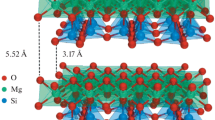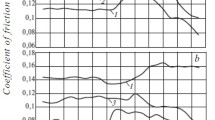Summary
-
1.
It has been shown that the antiwear, antiscoring, and antifriction action of friction polymers involves an improvement in the microgeometry of the friction surfaces.
-
2.
It has been established that friction polymers are formed upon introduction of the synthesized additives into the oil, and not by the components of the oil itself.
-
3.
Feasibility has been established for increasing the temperature limit of the antiwear and antiscoring action of polymer-forming additives by blocking in the course of synthesis.
-
4.
Feasibility has been demonstrated for the joint use of polymer-forming and other detergent-dispersant, anti-oxidant, and antifoam additives without any suppression of their functional properties. An improvement in compatibility of the indicated additives can be achieved by blocking the polymer-forming components.
Similar content being viewed by others
Literature cited
R. S. Fein and K. L. Kreuz, ASLE Trans.,8, No. 1, 29–38 (1965).
L. L. Goldblatt, Ind. Eng. Chem.,10, No. 3, 270–278 (1971).
“Limits of lubrication,” Conference of Imperial College, Ind. Lubrication and Tribology,23, No. 9, 319 (1971).
U.S. Pat. 3,513,084 (1970).
Yu. S. Zaslavskii, A. A. Berlin, R. N. Zaslavskii, K. E. Belozerova, V. A. Rusakova, and M. I. Cherkashin, Mashinovedenie,8, No. 3, 80–84 (1972).
Yu. S. Zaslavskii (J. S. Zaslavsky), A. A. Berlin, R. N. Zaslavskii (Zaslavsky), M. I. Cherkashin, K. E. Belozerova, and V. A. Rusakova, Wear,20, No. 3, 287–297 (1972).
M. V. Raiko and V. P. Kadomskii, Mashinovedenie,8, No. 4, 111–117 (1972).
A. F. Aksenov, A. A. Litvinov, Yu. I. Koropenko, V. N. Turchak, A. E. Borodin, and A. Ya. Shepel', Khim. Tekhnol. Topl. Masel, No. 9, 45–49 (1972).
F. G. Rounds, ASLE Trans.,9, No. 1, 88–100 (1966).
W. I. Grew and A. Cameron, Proc. Royal Soc. (London), Ser. A.,327, 47–59 (1972).
Yu. S. Zaslavskii, I. A. Morozova, A. P. Bondarenko, and S. V. Kozlova, Neftekhimiya,10, No. 3, 437–443 (1970).
I. A. Morozova, Yu. S. Zaslavskii, and A. P. Bondarenko, Khim. Tekhnol. Topl. Masel, No. 12 (1973).
Additional information
Translated from Khimiya i Tekhnologiya Topliv i Masel, No. 1, pp. 38–42, January, 1974.
Rights and permissions
About this article
Cite this article
Zaslavskii, Y.S., Zaslavskii, R.N., Cherkashin, M.I. et al. Influence of substances forming friction polymer on antiwear, antiscoring, antifriction, and detergent properties of lubricating oils. Chem Technol Fuels Oils 10, 50–54 (1974). https://doi.org/10.1007/BF00717223
Issue Date:
DOI: https://doi.org/10.1007/BF00717223




